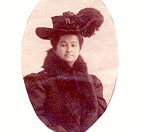Nannie and the Way It Was
by Jean Pond
Nannie grew up in Platt County, Missouri in the 1870s when Nannie was a name, not an occupation. Times were hard; you ate what you could raise and then you lined the root cellar with jars of what you could afford to put aside. You took a basket of your best preserves to the barn raisings. You used up some of the Pippins and the Northern Spies after rising at first light to make sure there would be enough apples pies for the threshers; perhaps you'd fill in with a few rhubarb pies.
Nannie was about sixty-five when I first knew her and she became one of the best arguments for oral history that I ever found, aside from the fact that she was my husband's beloved grandmother.
Marriages in Platt County weren't always weddings, but they were frequent. A man whose wife died in childbirth would often marry one of his wife's sisters in the next few months; someone had to take care of those children, left behind.
Even though the marriages weren't always made in heaven, they were a welcome social event. There was a devilish custom called a shivaree which was almost as much fun as a barn dance. During the wedding night, once the bridge and groom were in their connubial bed, the neighbors from miles around would descend with tin pans, buckets and horns or anything that would make an unholy noise and flush the couple out, preferably in their night clothes. After some off-color jokes and refreshments the marriage had the community's blessing.
Indian war parties were a thing of the past, but fortified by the white man's gift of alcohol, a number of Indians would make occasional visits. At those times Nannie, who was very young, had to stay quiet under the overturned wash tub until they had gone.
Other visitors would stop by and tie their horses to the fence. You might have recognized a couple from nearby Clay County: they were called the James boys, Frank and Jesse. Nannie was too small to cook up the platters of fried chicken and buttermilk biscuits, but she was allowed to help serve and to listen.
History has described the James boys as the scoundrels they were, but in their own community at the time they were considered more like folk heroes. Supposedly, they took from the rich and gave to the poor. At that time, the banks would part with their money only at exorbitant rates and that may have been appropriate considering the degree of risk banks were subject to at that time. It was possible for some Missourians to turn a blind eye to a little bank robbing and many even thought of the boys as martyrs, especially after some Pinkerton detective agents firebombed the home of Zerelda Samuel, their loving and formidable mother. Jesse's half brother was killed and Zerelda lost an arm. The Law said it was a flare, but the James supporters said it was a grenade. Zerelda staunchly defended her boys always.
Once she attempted to cash some bearer bonds in a bank from which they had been stolen. She outlived three husbands and Jesse who died at thirty-four. He was living quietly in Saint Joseph, Missouri using the name Thomas Howard.
Actually, it was domesticity that did him in. He was hanging a picture which gave a former associate, Bob Ford, who was attracted by the reward money, the opportunity to shoot him in the back of the head. Ironically, he was married to a woman also named Zerelda at the time of his death. Freud could have liked that.
Nannie's father had a vision of a promised land and when President Harrison announced the opening of 1.92 million acres, now a part of Oklahoma, to homesteaders it seemed like an opportunity.
The land rush was scheduled to begin at noon on April 22, 1889. The cavalry was to fire the signal. Nannie, who was now seventeen, and her father were ready in their buckboard. The noise, the dust, the confusion, the fights were all a part of the mass of horses, wagons, buckboards, buggies and even bicycles. The plan was that Nannie's brother would ride ahead on his fast horse and stake their claim. The confusion upset the horses who reared at the starting line. The officials thought he was making a break for it and shot the horse out from under him.Nannie, with sunbonnet snugged tight and a man's handkerchief pinned across her face to filter the dust, persevered. By nightfall Guthrie, their destination, had become a tent city of 15,000 people. Oklahoma City which had been a small water and coaling station for the Santa Fe railroad, was now a city of 10,000.
Some had slipped into the area early and illegally, and staked their claims; they were called 'Sooners'. The officials tried to deal with them and the continuing fighting that went on. One enterprising Sooner had staked his claim right in the middle of Main Street.Many years later, when a movie about the land rush came out titled Cimarron, starring Irene Dunne and Richard Arlen, Nannie's daughter took her elderly mother to the matinee. Nannie kept saying in audible whispers, "Sister, that was not the way it was!"
She may have been the only person who saw that picture who knew "the way it was."
©Jean Pond for SeniorWomen.com







